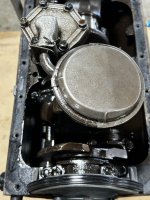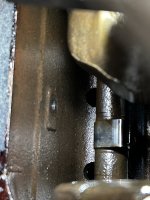dekeeb
Sharpest Tool
After getting my '55 pickup Super Hurricane running again after decades of slumber, I came across this oil leak which at first appeared to be a rear main oil leak. It wasn't until I did a bit of welding and grinding on the firewall did I identify the source of the leak via the trail the oil made through the grinding residue. When the block was clean, the oil leak was almost undetectable because the oil is fresh and nearly invisible as it come out of the threaded hole in the block. The oil will drip down from the hole, run into the oil pan gasket, and then wrap around the rear of the oil pan ad drip in the area of the rear main.
My question is: why is there a threaded hole in this location, and why does it only leak when the engine is running? Most importantly how do I resolve this leak?

My question is: why is there a threaded hole in this location, and why does it only leak when the engine is running? Most importantly how do I resolve this leak?





